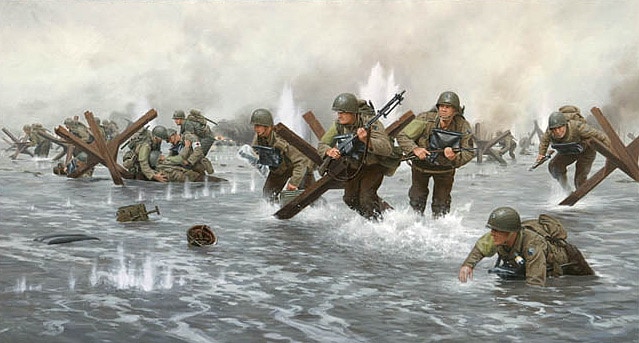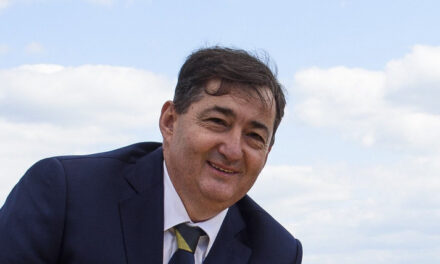The largest landing operation in history began on June 6, 1944, when the Anglo-Saxon allies opened a second front in Normandy on D-Day.
They delayed the opening of the second front
The German Führer, Adolf Hitler, who started the war on September 1, 1939, brought almost all of Europe under his control in two years. At the end of 1941, he finally gave up on the invasion of Great Britain and built the Atlantic Wall, a fortress system stretching from Norway to Spain, on the western coast of Europe.
After the German attack launched against the Soviet Union on June 22, 1941, without a declaration of war, the Soviet leader, Joseph Stalin, repeatedly demanded the opening of a second front from American President Franklin D. Roosevelt and British Prime Minister Winston Churchill, in order to withdraw German troops from the East from the front.
The Anglo-Saxon allies postponed this and then landed in Sicily in 1943, the operation only took place in the summer of 1944, when the initiative was already in the hands of the Red Army on the Eastern Front.
The invasion surprised the Germans, although they expected it, only elsewhere.
The Führer was firmly convinced that the Allies would try in the area of Calais, the narrowest part of the English Channel, and he was prepared (i.e. not prepared) anyway.
The Anglo-Saxons also considered this possibility, and then they came up with the idea: let the Germans believe what they wanted to believe. For this purpose, they invented an army group that never existed, for which they even built phantom camps in South-East England, and leaked such information to German spies.
Under house arrest
The development of the plans for Operation Overlord took place amid the strictest security measures, so for example the officers involved in the planning were kept under house arrest throughout.
In the well-known name "D Day", D is the abbreviation of the English word day, which is traditionally used to denote the date of an operation that began at an unknown exact time.
The weather forecasts indicate that June 5-7 is the most suitable. The period between 1950 and 1950 was marked, and although the sea was rough, American General Dwight D. Eisenhower, the Supreme Allied Commander, decided on June 5 that the landings would be carried out the next day.
The commander of naval operations was Sir Bertram Ramsey, the commander of the landing forces was General Bernard Montgomery. It played into the allies' hands that the commander of the German defense, General Rommel, traveled home to his wife, who was celebrating her fiftieth birthday, and the commander of the panzer division consolidated near Caen spent the night in Paris, with his lover.
Coded message
The "longest day" actually began late on June 5, 1944:
the BBC broadcast a coded message instructing the French Resistance to begin sabotage operations.
From midnight, 1,200 bombers of the air force dropped about 5,000 tons of bombs on the Atlantic coast from Le Havre to Cherbourg, and at two o'clock after midnight, 23,000 paratroopers were dropped in several waves to create bridgeheads, the first building in France to be liberated was a cafe in Benouville near the bridge.
At four o'clock in the morning, the largest fleet in history, 1,213 warships, 4,216 troop carriers, 736 supply ships and 864 merchant ships, arrived in front of the landing zones. After the closing fire on the German positions on the shore, at half past six in the morning, the landing began on the beaches named Omaha, Utah, Gold, Juno and Sword, and by the end of the day, 132,000 allied soldiers were put ashore.
They were covered by 12,000 planes, and on the German side, around 30,000 soldiers and 500 aircraft tried to resist. The famous photojournalist, the Hungarian Robert Capa, was also with the invasion forces, who photographed four rolls, but only 11 of the 106 grainy images remained usable. Even today, it is not known whether he deliberately "moved" his camera, or if the development went wrong is responsible for the blurry photos, in any case, for the world, they represent D-Day.
Confusion prevailed at the German headquarters
At the news of the invasion, the German headquarters were bewildered.
As usual, the Führer, who slept until late in the morning, and who had previously even negotiated with Hungarian Prime Minister Döme Sztójay, only issued the order in the afternoon to destroy the enemy in the bridgehead position.
However, he did not agree to the armored reserve being directed here, because he expected the real blow elsewhere. By the evening of June 6, the Allies managed to establish five bridgehead positions on a stretch of about 80 kilometers, where they continuously put soldiers and equipment ashore.
Two concentrated counterattacks by the Germans collapsed, and within days the Allied Air Force gained unlimited air superiority on the Western Front.
Although the goals set for the first day were only partially achieved: the strategically important cities of Cabourg and Caen could not be taken, and there was no contact between the bridgeheads, the loss was much lower than the 40 thousand previously estimated, about ten thousand, of whom more than four thousand were in the on the dead list.
Featured Image Credit: Gettysburg Museum of History












